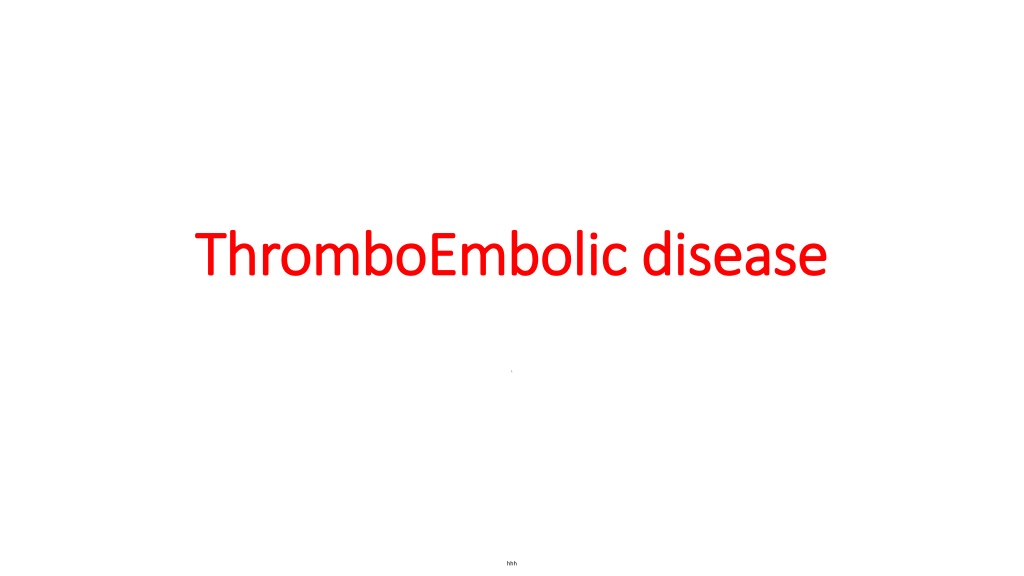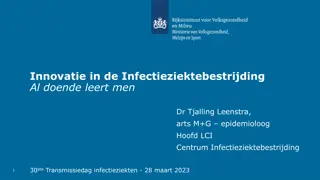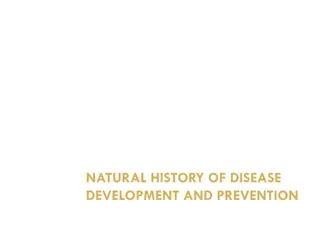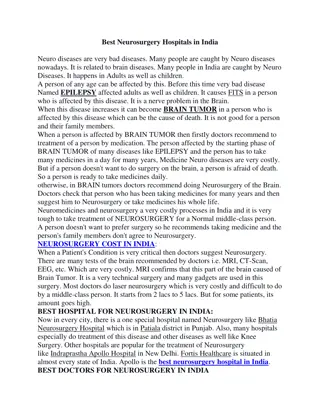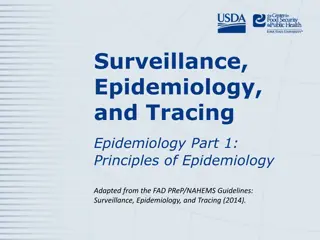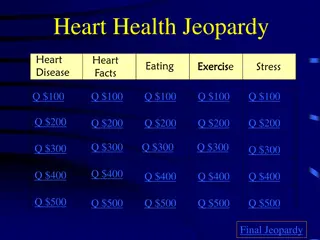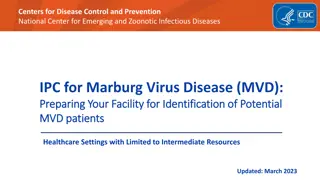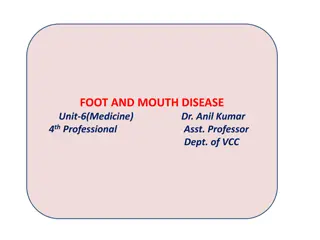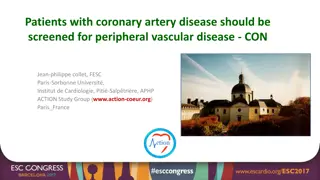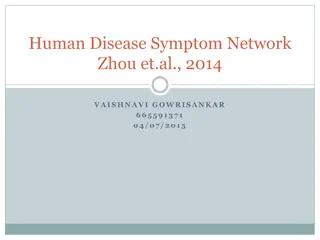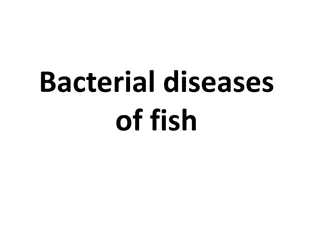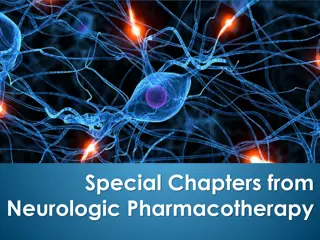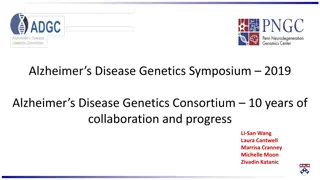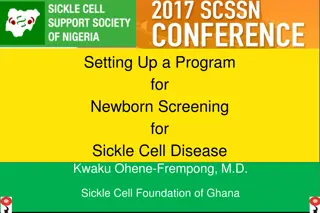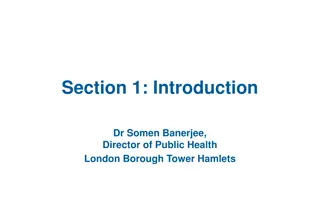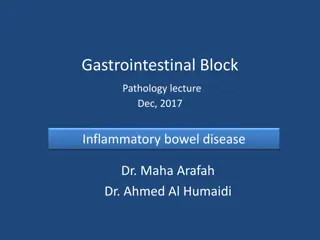ThromboEmbolic disease
Thromboembolic disease involves the formation of blood clots that can lead to serious health complications like Deep Venous Thrombosis, Pulmonary Embolism, Stroke, and more. Factors like abnormalities in blood flow, vessel walls, and hypercoagulability play a crucial role in the development of these pathologic clots. Clot formation occurs through platelet adhesion, activation, and aggregation, ultimately leading to the formation of arterial and venous thrombi. Learn about the etiology and implications of thromboembolic disease with this comprehensive overview.
Download Presentation

Please find below an Image/Link to download the presentation.
The content on the website is provided AS IS for your information and personal use only. It may not be sold, licensed, or shared on other websites without obtaining consent from the author.If you encounter any issues during the download, it is possible that the publisher has removed the file from their server.
You are allowed to download the files provided on this website for personal or commercial use, subject to the condition that they are used lawfully. All files are the property of their respective owners.
The content on the website is provided AS IS for your information and personal use only. It may not be sold, licensed, or shared on other websites without obtaining consent from the author.
E N D
Presentation Transcript
ThromboEmbolic disease ThromboEmbolic disease hhh
Definition Thrombosis is the process involved in the formation of a fibrin blood clot. Both platelets and a series of coagulant proteins (clotting factors) contribute to clot formation. An embolus is a small part of a clot that breaks off and travels to another part of the vascular system. Damage is caused when the embolus becomes trapped in a small vessel, causing occlusion and leading to ischemia or infarction of the surrounding tissue. Types of thromboembolic diseases Deep venous thrombosis (DVT) and its primary complication, pulmonary embolism (PE), stroke Cardiogenic Thromboembolism --other systemic manifestations of embolization of clots that form within the heart
Etiology of Thromboembolism Three primary factors influence the formation of pathological clots First, abnormalities of blood flow that cause venous stasis can result in DVT, which can progress to PE Intracardiac stasis of blood can also result in stroke or other systemic manifestations. Second ,abnormalities of blood vessel walls, such as injury or trauma to the vasculature. The presence of artificial heart valves and central venous catheters, Third, hypercoagulability resulting from alterations in the availability or the integrity of blood- clotting components or naturally occurring anticoagulants also represents a significant risk factor for thromboembolic disease.
Clot Formation Clot Formation Platelet Adhesion, Activation, and Aggregation Endothelial damage leads to exposure of blood to subendothelial collagen and phospholipids, resulting in platelet adhesion to the surface via the glycoprotein I (GPI) receptor on the platelet surface. Adhered platelets become activated and release numerous compounds, including adenosine diphosphate and thromboxane A2, which stimulate platelet aggregation. Fibrinogen serves as the binding ligand for platelet aggregation, via the GPIIb/IIIa receptor on the platelet surface. Clotting Cascade Figure 15-2 Simplified clotting cascade. Components in ovals are influenced by heparin; components in boxes are influenced by warfarin.
Pathological Thrombi Pathological Thrombi classified according to location and composition. Arterial thrombi are composed primarily of platelets, fibrin and occasional leukocytes. Arterial thrombi generally occur in areas of rapid blood flow (i.e., arteries) initiated by spontaneous or mechanical rupture of atherosclerotic plaques. Venous thrombi composed almost entirely of fibrin and erythrocytes , have a small platelet head generally form in response to either venous stasis or vascular injury after surgery or trauma. The areas of stasis prevent dilution of activated coagulation factors by normal blood flow.
Risk Factors Risk Factors Those related to blood flow Those related to Abnormalities of clotting component Those related to Abnormalities of surface contact with blood
Antithrombotic Agents Antithrombotic Agents The selection of an antithrombotic agent may be influenced by the type of thrombus to be treated. Anticoagulants Heparin, (unfractionated heparin [UFH]) low-molecular-weight heparins, (LMWHs) factor Xainhibitors (Fondaparinux) Direct Thrombin Inhibitors (Argatroban, lepirudin and bivalirudin)) warfarin are used in the treatment and prevention of both arterial and venous thrombi. Antiplatelet Drugs that alter platelet function Aspirin alone and in combination with anticoagulants, are used in the prevention of arterial thrombi. Clopidogrel is a pro-drug that is metabolized in part to an active thiol derivative. The latter inhibits platelet aggregation Dipyridamole is used by mouth as an adjunct to oral anticoagulation for prophylaxis of thromboembolism associated with prosthetic heart valves.
Glycoprotein IIb/IIIa inhibitors prevent platelet aggregation by blocking the binding of fibrinogen to receptors on platelets. Abciximab. Abciximab is a monoclonal antibody which binds to coronary glycoprotein IIb/IIIa receptors and to other related sites. Eptifibatide and tirofiban. Eptifibatide and tirofiban also inhibit glycoprotein IIb/IIIa receptors; they are licensed for use with heparin and aspirin to prevent early myocardial infarction in patients with unstable angina or non-ST-segment elevation myocardial infarction (NSTEMI).
Fibrinolytic agents are used for rapid dissolution of thromboemboli, during myocardial infarction (MI). Streptokinase. Streptokinase was the first agent available in this class. Alteplase. Tissue plasminogen activator (rt-PA) or alteplase was developed using recombinant DNA technology Reteplase and tenectaplase., are also fibrin-specific agents and so heparin is required to prevent rebound thrombosis Urokinase. Urokinase, like alteplase and streptokinase, can be used for the treatment of deep vein thrombosis and PE.
Endogenous Antithrombotic Endogenous Antithrombotic Protein S Cofactor for activation of protein C Protein C Inactivates factors Va and VIIIa Tissue factor pathway inhibitor Inhibits activity of factor VIIa Plasminogen Converted to plasmin via tissue plasminogen activator Plasmin Lyses fibrin into fibrin degradation products
Tests Used to Monitor Antithrombotic Therapy 1-Prothrombin PT- Time/International Normalized Ratio INR The PT is prolonged by: deficiencies of clotting factors II, V, VII, and X, low levels of fibrinogen and very high levels of heparin. alterations in the extrinsic and common pathways 2-Activated Partial Thromboplastin Time -APPT The aPTT reflects alterations in the intrinsic pathway monitor heparin therapy. 3-Anti-XaActivity Because these agents are eliminated renally, patients with severe renal failure may accumulate LMWHs, leading to an increased risk of hemorrhagic complications
Deep Venous Thrombosis (DVT) Clinical Presentation physical findings of DVT is unilateral leg swelling that often is accompanied by warmth and local tenderness or pain. Atender, palpated, cordlike entity caused by venous obstruction Discoloration of the affected limb, including pallor from arterial spasm, cyanosis from venous obstruction, or a reddish color from perivascular inflammation, may also occur. (>50%) can present with asymptomatic disease, patients can have long-term complications such as recurrent DVT or postthrombotic syndrome. Because symptoms of DVT are nonspecific, the diagnosis must be confirmed by objective testing.
Diagnosis 1. The most common noninvasive test is Doppler ultrasonography to visualize veins and thrombi while investigating flow patterns. 2. Other noninvasive testing options include scanning (injection of radiolabeled fibrinogen followed by scanning to detect areas of accumulation corresponding to thrombosis), 3. D-dimer (an evaluation of the presence of fibrin degradation products, indicative of clot formation). 125I-fibrinogen leg
Treatment Optimal Therapeutic Range and Duration of Anticoagulation Target INR (Range) Indication Thromboembolism (DVT, PE) Treatment/prevention of recurrence (including calf vein and upper extremity DVT) Transient risk factors 2.5 (2.0 3.0) 3 months Idiopathic/first episode 2.5 (2.0 3.0) 6 12 DurationComment Consider chronic therapy Preceded by LMWH 3 6 months Consider chronic therapy months Recurrent VTE With malignancy 2.5 (2.0 3.0) Chronic 2.5 (2.0 3.0) Chronic Hypercoagulable state 2.5 (2.0 3.0) 6 12 months Two or more thrombophilic conditions Antiphospholipid antibody syndrome With recurrent VTE or other risk factors Chronic thromboembolic pulmonary hypertension Cerebral venous sinus thrombosis 2.5 (2.0 3.0) 12 months Consider chronic therapy 2.5 (2.0 3.0) 12 months Consider chronic therapy 2.5 (2.0 3.0) 12 months Consider chronic therapy 2.5 (2.0 3.0) Chronic 2.5 (2.0 3.0) 3 6 months
Initiation of Therapy Optimal anticoagulant therapy is indicated to minimize thrombus extension and its vascular complications, prevent PE. Treatment options include IV UFH therapy initiated with a loading dose followed by a continuous infusion, adjusted-dose SC for UFH, or LMWH or fondaparinux administered by SC injection.
Heparin Loading Dose-A loading dose of heparin is required for several reasons.: First, therapeutic serum level will be achieved more quickly; to help prevent progression of clot will occur rapidly. Second, a relative resistance to anticoagulation exists during the active clotting process. Therefore, a larger
initial dose generally is necessary to achieve a therapeutic effect. Initial heparin loading doses of 70 to 100 U/kg followed by an infusion rate of 15 to 25 U/kg/hour are commonly recommended. To ensure accuracy, the clinician should obtain aPTT values no sooner than 6 hours after a bolus dose or any change in the infusion rate. Adherence of a thrombus to the vessel wall and subsequent endothelialization usually takes 7 to 10 days. Anticoagulation therapy must generally continue for 3 to 6 months to prevent recurrent thrombosis. Warfarin is preferred for this long-term anticoagulation because it can be administered orally, and it is generally initiated on the same day as heparin.
Shortening the duration of heparin therapy is associated with an increased risk of recurrent thrombosis. Adverse Effects Thrombocytopenia 1. Heparin-associated thrombocytopenia (HAT) 2. Heparin-induced thrombocytopenia (HIT), Hemorrhage Osteoporosis. Hyperkalemia- Hypersensitivity Reactions
Low-Molecular-Weight Heparin Based on these advantages, outpatient use of LMWH has become the most common approach to treatment of uncomplicated DVT. Fondaparinux considered as an alternative treatment option to the LMWHs Fondaparinux has the benefit that HIT has not been associated with its use.
Prevention Nonpharmacologic Measures Mechanical interventions e.g elastic compression stockings, as well as leg elevation, leg exercises, and early postoperative ambulation. Intermittent pneumatic compression (IPC) of the leg muscles, using inflatable cuffs Pharmacologic Measures Fixed, low-dose unfractionated heparin (LDUFH), administered as 5,000 U SC Q 8 to 12 hr depending on the indication, Fixed-dose SC LMWH and fondaparinux are alternative approaches for preventing DVT
Pulmonary Embolism Clinical Presentation The nonspecificity of symptoms. subjective symptoms are dyspnea, pleuritic chest pain, apprehension (anxiety or a feeling of impending doom), and cough. Hemoptysis occurs occasionally. The objective signs are tachypnea at a rate of 20 breaths/minute, tachycardia of 100 beats/minute, second heart sound (P2), and rales. DVT precedes PE in 80% or more of patients. Acombination of these signs and symptoms provides further evidence for acute PE.
Diagnosis Chest radiograph, ECG, and arterial blood gas pulmonary angiography has been considered the gold standard for diagnosis of PE spiral computed tomography (CT) scans are useful and the most frequently used V/Q scans diagnostic procedures to document the presence of PE
Treatment PE should not be treated on an outpatient basis. Treatment options for PE include IV UFH therapy initiated with a loading dose followed by a continuous infusion. UFH therapy could be started with a loading dose of 7,200 U (80 U/kg 90 kg), followed by continuous infusion of 1,600 U/hour (18 U/kg/hour 90 kg). Monitoring of the aPTT would be used to adjust dosing to maintain treatment within the therapeutic range . The alternative a SC LMWHor SC fondaparinux. Thrombolytic therapy should be reserved for patients with acute massive embolism, who are hemodynamically unstable (SBP <90 mmHg) and at low risk for bleeding.
Warfarin initiate therapy in ambulatory patients; Heparin or LMWH/fondaparinux therapy should be continued for at least 5 days in the setting of PE, and until warfarin therapy is therapeutic and stable. Warfarin should be started on the first day of hospitalization and continued for a minimum of 3 to 6 months or longer, if indicated
Initiation of Therapy Two methods for initiation of warfarin therapy have been developed. 1. The average daily dosing method, patients are typically started at 4 to 5 mg daily, with dosing adjustments as necessary until the therapeutic goal is reached. 2. Another popular dosing algorithm used a 10-mg initiation dose for the first 2 days, with the INR on day 3 used to guide dosing on days 3 and 4, and the INR on day 5 used to guide the next three doses..
Duration of Therapy Patients with (idiopathic) DVT or PE, should be treated for at least 6 to 12 months, as their likelihood of having a recurrent event as 30% over 5 years. Patients with DVT or PE associated with transient or reversible risk factors are usually treated for 3 to 6 months, as the risk of recurrence is lower (approximately 10% over 5 years). patients with recurrent DVT/PE and persistent risk factors, warfarin treatment should be continued indefinitely
Adverse Effects Hemorrhage ,Menstrual blood flow older patients are more sensitive to the effects of warfarin and, therefore, require lower dosages than younger patients. Skin Necrosis Purple Toe Syndrome
Factors Influencing Dosing 1-Dietary Vitamin K 2-Alcohol Ingestion 3-Underlying Disease States: Diarrhea-associated alterations in intestinal flora can reduce vitamin K absorption, Fever enhances the catabolism of clotting factors Heart failure, hepatic congestion, and liver disease can also cause significant reduction in warfarin metabolism. End-stage renal disease is associated with decreased CYP2C9 activity, . Hypothyroidism decreases the catabolism of certain clotting factors, Conversely, hyperthyroidism increases the catabolism of clotting factors, leading to an increased sensitivity to warfarin.. 3-Genetic Factors 4-Other Factors Acute physical or psychological stress ,Smoking .
